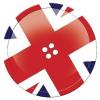V-Engines vs Boxer Engines
#1

Posted 16 May 2001 - 10:30
Now let me take it a little further. What if a team developes an engine which has even greater angle, let's say 180 degrees?
Provided that this second engine has no problems (or the team manages to solve them), is it going to be better than today's engines at 90 or less degrees?
Best regards
Advertisement
#2

Posted 16 May 2001 - 10:49
Why does a larger V angle mean more vibration?
Actually I can make a guess at the subject question.
To minimise vibrations and reduce any chance of the engine falling apart the enigne itself would have to be stronger=>bigger and heavier.
I think it would depend on if they could strengthen the engine block without increasing the weight significantly. If they could then a lower CoG would be an obvious benefit (assuming they could package the exhaust and stuff well)
#3

Posted 16 May 2001 - 11:30
In the past, I've written a little more in the F1 FAQ: http://www.atlasf1.c.../nov22/faq.html
#4

Posted 16 May 2001 - 20:20
#5

Posted 16 May 2001 - 21:47
That would have some benefits.
#6

Posted 17 May 2001 - 11:08
With todays diffusers, and the coke-bottle shape read-ends, the same problems would apply, i.e. poor aerodynamics.
#7

Posted 18 May 2001 - 20:53
Originally posted by nzkarit
Would the boxxers lower the center of gravity?
That would have some benefits.
The boxer design has a lower center of gravity but since they are designed with the exhaust exiting the bottom of the block the entire engine must be raised. Therefore they end up with a higher center of gravity in cars so low to the ground and with Venturi ground effects.
#8

Posted 19 May 2001 - 07:52
#9

Posted 19 May 2001 - 15:34
#10

Posted 01 December 2001 - 00:24
EDIT; the boxing of this type is not adjacent to whichever cylinder is at question but does box between other cylinders that are not adjacent. M.L. Anderson
#11

Posted 01 December 2001 - 23:16

This Porsche 908 was a very successful flat-8 design. Factory blueprints of this engine are, I am pretty sure, available for purchase on the web. Try Googling "Porsche 908 blueprints" and you can find the source.
#12

Posted 06 December 2001 - 03:16
V10s with flat ignition timing comes with a lot of vibration. so there is not an 'ideal' v, such as V6s and V12s and even V8s. If the FIA decided that there was no limit to fuel allowed in the pit lane, manufactures would revert to V12s, now illegal.
#13

Posted 07 December 2001 - 01:32
#14

Posted 07 December 2001 - 09:06
#15

Posted 07 December 2001 - 22:06
#16

Posted 09 December 2001 - 03:14
Simply put, it is a throw sequence and firing order for power instead of smoothness. Ferrari designed bothe the F360 engine and the Maserati 3200 and 4200. The F360 has the flat firing order.
Originally posted by marion5drsn
Brain, please explain the "flat" ignition timing you speak of as I don't recall ever seeing this phrase used in this way before. Yours, M.L. Anderson
#17

Posted 23 December 2001 - 23:47
One must always keep in mind the fact that aircraft engines in general turn to the right (Pilots view CW) whereas auto engines turn left (Drivers view CCW). This is possibly due to the fact that some old aircraft engines cranked from the back.
One thing that struck me was the crudeness of the timing of the spark system (Dual Magnetos) that seems so out of date in 2001. Most of the engines seem to have fuel injection. But then again aircraft engines need dependability as a first and last requirement.
The Firing Order is # 1 – 5 – 8 – 3 – 2 – 6 – 7 – 4. This is given above and to the left of the diagram and also in others parts of the Manual. The spark plug wires and so forth follow the same numbers.
The crankshaft is 28.226” from the back end of the crank to the forward thrust face, a very long crank, 720 cubic inches, or 11.8L. Am now in the process of trying to figure out just how many firing orders there would be if Chevrolet made a 180-degree
#18

Posted 18 January 2002 - 19:49
Ben
#19

Posted 23 January 2002 - 17:22

















